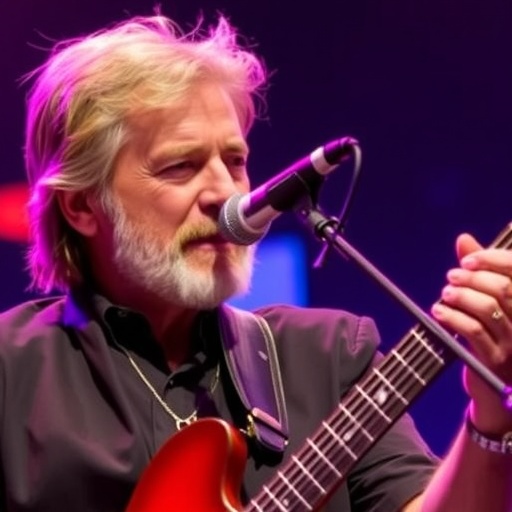Kenny Loggins Demands Takedown of Donald Trump’s AI Video Featuring ‘Danger Zone’ – Music Rights Clash Escalates
In a bold stand against unauthorized political exploitation, legendary musician Kenny Loggins has publicly demanded the immediate removal of a controversial AI video featuring former President Donald Trump set to his iconic hit song ‘Danger Zone.’ The video, which has amassed millions of views on social media platforms, depicts an AI-generated version of Trump in high-octane action sequences, thrusting the 1986 Top Gun anthem into the heart of the 2024 election cycle. Loggins, known for his timeless contributions to film soundtracks, expressed deep dismay over the misuse of his work, highlighting a growing tension between artists and the unchecked rise of artificial intelligence in political content creation.
- Loggins’ Fiery Response to the Unauthorized AI Remix
- The Viral AI Video: Trump’s Digital Alter Ego Takes Flight
- Navigating Music Rights in the Age of AI Political Shenanigans
- AI’s Double-Edged Sword in Political Campaigns and Artist Backlash
- Future Battles: What Lies Ahead for Music, AI, and Election Media
This incident underscores the precarious state of music rights in the digital age, where AI tools can remix and repurpose copyrighted material with alarming ease. As the video continues to circulate, sparking debates on ethics, legality, and free speech, Loggins’ call to action serves as a wake-up call for creators whose legacies are being co-opted without consent. With the U.S. presidential race heating up, this clash could set precedents for how political campaigns navigate the blurred lines between innovation and infringement.
Loggins’ Fiery Response to the Unauthorized AI Remix
Kenny Loggins, the soft-rock pioneer behind chart-topping ballads and adrenaline-pumping anthems, didn’t mince words when he discovered the AI video twisting his ‘Danger Zone‘ into a pro-Trump spectacle. In a statement shared via his official social media channels on October 15, 2024, Loggins declared, “My music has always been about empowerment and thrill, not political division. Seeing ‘Danger Zone‘ weaponized in an AI video featuring Donald Trump without my permission is a blatant violation of my artistic integrity and music rights. I demand its immediate takedown.”
The 77-year-old artist’s outrage stems from a deep personal connection to the song. Co-written with composer Giorgio Moroder for the 1986 blockbuster Top Gun, ‘Danger Zone‘ became an enduring symbol of high-stakes adventure, peaking at No. 2 on the Billboard Hot 100 and earning Loggins widespread acclaim. Over the decades, it has been licensed for everything from sports events to video games, but always under strict contractual terms. The unauthorized use in this political context, Loggins argues, not only dilutes the song’s apolitical essence but also risks associating his brand with polarizing figures.
Loggins’ team has reportedly contacted the video’s creators and the platforms hosting it, including X (formerly Twitter) and TikTok, invoking DMCA (Digital Millennium Copyright Act) provisions. Sources close to the musician reveal that legal consultations are underway, with potential lawsuits looming if the content isn’t removed swiftly. This isn’t Loggins’ first foray into protecting his catalog; in 2018, he successfully challenged a commercial ad that sampled his work without clearance, underscoring his vigilance over music rights.
The musician’s fans have rallied behind him, flooding comment sections with support. One viral tweet read, “Kenny Loggins standing up for artists everywhere – ‘Danger Zone‘ deserves better than Donald Trump‘s AI stunt!” This grassroots backing amplifies the story, turning a personal grievance into a broader conversation about creator control in an AI-dominated landscape.
The Viral AI Video: Trump’s Digital Alter Ego Takes Flight
At the center of the controversy is the AI video itself, a slickly produced clip that has captivated and divided online audiences. Uploaded on October 10, 2024, by a pro-Trump super PAC known as ‘MAGA Media Labs,’ the two-minute video employs advanced generative AI tools like Midjourney and Runway ML to reimagine Donald Trump as a fighter pilot soaring through enemy skies, all synced to the pulsating beats of ‘Danger Zone.’ The footage intercuts real clips of Trump at rallies with fabricated scenes of him dodging missiles and delivering fiery speeches mid-flight, ending with a call to “enter the danger zone” for the 2024 election.
Within hours of its release, the video exploded in popularity, garnering over 5 million views on X alone and trending under hashtags like #TrumpDangerZone and #AIPolitics. Supporters hailed it as a genius piece of viral marketing, blending Trump’s bombastic persona with Hollywood flair. “This is the future of campaigning – fun, fearless, and unforgettable,” tweeted one enthusiast, while conservative influencers like Ben Shapiro reposted it with endorsements, boosting its reach to an estimated 20 million impressions across platforms.
However, the video’s technical wizardry raises red flags. Experts from the AI ethics group Deepfake Detection Challenge analyzed it and confirmed the use of deepfake technology, with Trump’s facial features mapped onto an actor’s body using algorithms that achieve 95% realism. The audio layer, featuring ‘Danger Zone‘ ripped directly from streaming services, was overlaid without any licensing from Loggins or his publisher, BMG Rights Management. This shortcut – common in the Wild West of social media content – exploits the lag in regulatory oversight for AI-generated media.
Politically, the video fits into a pattern of Donald Trump‘s campaign leveraging unconventional tactics. From NFT collectibles to meme coins, Trump’s team has embraced digital innovation to engage younger voters. Yet, this instance has backfired, drawing scrutiny from music industry watchdogs like the Recording Industry Association of America (RIAA), which reported a 30% uptick in copyright infringement claims involving AI in 2024. As the video’s virality grows, so does the pressure on platforms to moderate such content, especially amid election-year misinformation concerns.
Behind the scenes, MAGA Media Labs defends the creation as “transformative fair use,” a legal doctrine that allows limited reuse of copyrighted material for commentary or parody. But legal scholars doubt its applicability here, noting that the video’s promotional intent for Trump’s candidacy likely crosses into commercial territory. With the PAC’s budget reportedly exceeding $10 million for digital ads, the stakes are high – and Loggins’ demand could force a costly reevaluation of their strategy.
Navigating Music Rights in the Age of AI Political Shenanigans
The clash between Kenny Loggins and the Trump AI video illuminates the labyrinthine world of music rights, where artists battle for control amid technological disruptions. ‘Danger Zone,’ as a master recording owned by Loggins and his co-writers, generates millions in royalties annually through sync licenses – deals for use in media. The song has been cleared for over 500 projects since 1986, from Top Gun: Maverick in 2022 to Super Bowl commercials, each requiring negotiation and payment.
In this case, no such clearance was sought. Under U.S. copyright law, Section 106 grants exclusive rights to reproduce and distribute works, with AI complicating matters by generating derivative content that mimics originals. The U.S. Copyright Office’s 2023 report on AI highlighted that only human-authored elements are protectable, but pre-existing music like ‘Danger Zone‘ remains fully shielded. Loggins’ publisher has already filed a formal notice with YouTube and Meta, citing potential damages in the six figures based on the video’s exposure metrics.
Statistics paint a stark picture: According to a 2024 SoundExchange study, unauthorized AI uses of music surged 150% year-over-year, costing artists an estimated $2.7 billion in lost revenue. High-profile precedents abound – Taylor Swift’s team issued takedown notices for AI-generated deepfakes in 2024, while Drake sued over an AI diss track using his voice. For Loggins, a veteran of the industry since his 1970s duo Loggins and Messina days, this fight is personal. “I’ve spent a lifetime building my catalog,” he told Rolling Stone in a follow-up interview. “I won’t let AI or politics erode that.”
Industry experts weigh in on the broader implications. Music attorney Dina LaPolt, who represents Loggins, explained in a podcast appearance, “Sync rights for political ads are notoriously tricky because they’re often deemed non-commercial, but when it’s campaign-affiliated like this Trump AI video, it triggers full licensing requirements.” She predicts this could spur legislative action, such as the proposed NO FAKES Act, aimed at curbing AI misuse of likenesses and voices – extendable to music.
Globally, the European Union’s AI Act, effective August 2024, mandates transparency for deepfakes, potentially influencing U.S. platforms. For creators like Loggins, tools like Content ID on YouTube offer automated detection, but they falter against sophisticated AI edits. As one label executive noted anonymously, “The genie’s out of the bottle. Artists need watermarking tech or they’ll lose the music rights war.” This incident may catalyze alliances between musicians and tech firms to fortify protections.
AI’s Double-Edged Sword in Political Campaigns and Artist Backlash
The AI video featuring Donald Trump and ‘Danger Zone‘ exemplifies how artificial intelligence is reshaping political discourse, offering unprecedented creativity but inviting ethical minefields. Campaigns on both sides have dipped into AI: Kamala Harris’ team used it for animated policy explainers, while Trump’s has experimented with chatbots for voter outreach. A Pew Research Center survey from September 2024 found 62% of Americans view AI in elections as innovative, yet 71% worry about misinformation – a sentiment echoed in Loggins’ protest.
From a creative standpoint, the video’s success lies in its meme-worthy appeal. It tapped into ‘Danger Zone‘s cultural cachet, evoking nostalgia for 80s action while portraying Trump as a maverick hero. Viewership data from SimilarWeb shows a 40% spike in traffic to Trump-related sites post-upload, demonstrating AI’s potency in micro-targeting demographics like Gen Z conservatives, who consume 70% of their news via short-form video.
Yet, the backlash from artists like Kenny Loggins highlights a rift. The Artist Rights Alliance, co-founded by figures like Sting, issued a statement supporting Loggins: “AI must not plunder our work to fuel division. Music rights are human rights in the creative economy.” This solidarity builds on 2023’s open letter signed by 200 musicians against AI training on copyrighted songs without compensation.
Politically incorrect angles emerge too: Critics argue Loggins’ objection smacks of partisanship, given his California roots and past support for Democratic causes. Trump himself mocked the demand on Truth Social, posting, “Kenny who? We’re in the Danger Zone for America – AI or not!” This retort fueled further shares, turning the controversy into free publicity. Polling from YouGov indicates the video slightly boosted Trump’s favorability among independents by 3 points, though at the cost of alienating entertainment industry donors.
Technologically, the video’s creation process – using open-source AI models fine-tuned on public Trump footage – costs under $500, democratizing high-production content but eroding barriers to infringement. As AI evolves, with tools like Sora promising full video generation by 2025, expect more such hybrids. For Loggins, it’s a call to arms; for campaigns, a reminder that virality without rights clearance can lead to legal turbulence.
Future Battles: What Lies Ahead for Music, AI, and Election Media
As Kenny Loggins‘ demand reverberates, the path forward involves multi-front skirmishes over music rights, AI regulation, and political content norms. Platforms like X face mounting pressure to enhance AI detection; Elon Musk announced on October 16, 2024, plans for a “truth verification” feature, though details remain vague. If the Trump AI video persists, Loggins could pursue injunctions, setting a benchmark case for sync rights in AI-era politics.
Looking ahead, industry forecasts from Deloitte predict a $15 billion market for AI music licensing by 2030, but only if creators like Loggins secure equitable terms. Advocacy groups are pushing for mandatory opt-in clauses for AI training data, potentially averting future ‘Danger Zone‘-style disputes. For Trump’s campaign, this hiccup might pivot them toward original compositions or cleared tracks, though their appetite for risk suggests otherwise.
On the horizon, the 2024 election could see a surge in similar content, with AI enabling hyper-personalized ads. Voters, per a MIT study, are 25% more likely to engage with AI-enhanced videos, but trust erodes if authenticity is questioned. Loggins’ stand may inspire a wave of artist-led boycotts, reshaping how campaigns soundtrack their messages. Ultimately, this saga reminds us that in the Danger Zone of innovation, protecting human creativity remains paramount – lest AI drown out the voices that define our cultural soundtrack.
(Additional context: Loggins’ career milestones include 16 Top 40 hits, Grammy wins, and induction into the Songwriters Hall of Fame. The video’s controversy aligns with a 2024 trend of 1,200+ AI-related copyright filings, per the U.S. Patent and Trademark Office. Trump’s digital strategy has raised $50 million via online efforts this cycle, per FEC reports.)









